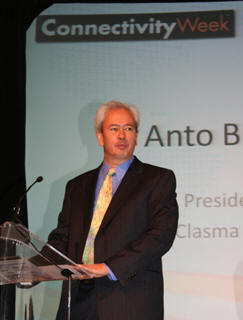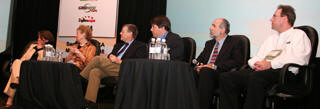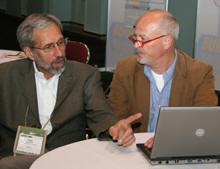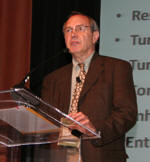June 2008
![]()
AutomatedBuildings.com
[an error occurred while processing this directive]
(Click Message to Learn More)
June 2008 |
[an error occurred while processing this directive] |
|
|
Frank Capuano, Strata Resource Inc acted as manager, editor and photographer for the daily show newspaper for Clasma Events |
The following articles appeared in the ConnectivityWeek Show Daily newspaper, published the week of May 19, 2008. Each article contains additional information that could not be included in the original publication due to space limitations. The additional information provides details relevant to the subject matter in an effort to provide a more complete overview of ConnectivityWeek events. Frank Capuano of Strata Resource Inc acted as manager, editor and photographer for the daily show newspaper for Clasma Events.
|
|
|
|
|
|
|
|
|
|
|
|
|
|
|
|
|
|
|
|
|
[an error occurred while processing this directive] |
Roundtable Discussions Define
Facets of Industry
Monday May 19, 2008
On Monday there were four workshops - Building System Basics, OpenADR Workshop, CSI roundtable and Open Source roundtable.
The Building System Basics workshop was conducted by Sean Kennedy of Voyant Solutions (www.voyantsolutions.com) and Tracy Markie of Engenuity Systems (www.engenuity.com). They covered the basic functionality of building mechanical and control equipment associated with the HVAC (Heating, Ventilation & Air-Conditioning), Access Control, CCTV & Digital Video and Lighting systems. Once the basic mechanical systems and components were covered their focus shifted to integration of control systems into a single cohesive Building Automation System (BAS) using gateways and the Open System standards of LonWorks and BACnet.
During this session, discussions centered on integration opportunities and obstacles. The opportunities for integration were well understood by the audience. Many technical obstacles between the Open System technologies were discussed along with IP and XML access to the BAS. The most discussed obstacle was the apparent disconnect between the owner, the architect and the integrator in regards to understanding the available technology, driving integration and collaborating towards a common goal. It was ultimately suggested that there appears to be a need for a Master System Integrator who oversee the integration process from design to operation and has the authority and responsibility for the proper installation of the BAS.
The OpenADR (Open Automated Demand Response) Workshop focused on the DRAS (Demand Response Automation Server) standards initiative. The DRAS initiative has created the OpenADR open standards for interfacing varied AutoDR systems to enable platform-independence and interoperability among end-to-end DR systems and buildings.
This, standing room only, session included presentations of a technical nature describing the details of the OpenADR standard and the connection between BAS standards and OpenADR. Panelists and presenters included Mary Ann Piette, Peter Palensky and Girish Ghatikar from the Lawrence Berkeley National Lab (http://drrc.lbl.gov/openadr/), Ed Koch from Akuacom (www.akuacom.com), Dave Resch from Cassatt (www.cassatt.com), Leighton Wolffe from Constellation NewEnergy (www.newenergy.com/portal/site/cne), David Holmberg from NIST speaking in regards to BACnet and DR, Toby Considine of University of North Carolina speaking in regards to oBIX and DR (http://www.oasis-open.org/committees/tc_home.php?wg_abbrev=obix), and Ron Bernstein of LonMark International (www.lonmark.org).
The CSI roundtable provided a lively forum for discussing the true nature and function of the project specification document and who is (or should be) ultimately responsible for the proper specification creation and implementation. The specification process is taking on a life of its own and it is dramatically changing the way buildings are built – and in some cases, how buildings are maintained. The roundtable discussion covered many points and issues facing building construction specification including the following comments:
Tight specifications are the best way for the owner to get what they want; however, the specification needs to be loose enough to foster competitive bidding.
Specifications sometimes become a patchwork of proprietary initiatives, rather than a comprehensive plan for a working building.
Performance standards should be the benchmark of specification writing as opposed to product specification.
Integrators are not defined in the specification, but they are vital for making the building operate properly.
Integrators are the new essential building trade.
They also covered how the Building Information Model (BIM) is changing the specification dynamic by using an IT approach. BIM is not a specification standard, but a way to manage the building systems operation over the lifetime of the building. BIM will rapidly evolve into online collaboration and change the way buildings are viewed after the construction phase.
Also discussed was how LEEDs perturbs the specification process and ultimately becomes an overlay to the CSI specification.
For more information on LEEDs and the CSI MasterFormat got to www.usgbc.org and www.csinet.org.
The Open Source roundtable, conducted by Anno Scholten of NovusEdge (www.novusedge.com) discussed the practicality and potential of creating a BAS open source platform – a Meta Architecture - where software tool, user interface and network management vendors could create modules that a facility owner could select from and easily integrate together to meet their specific control needs. The goal of creating a Meta Architecture is to have an interoperable middleware layer to complement the open philosophies of the field level. Several obstacles exist for this fledgling initiative, including the economic motivation for the owner. Much of the conversation on obstacles and lack of acceptance in the marketplace for Open Source was very reminiscent of arguments against Open System standards a decade ago before general adoption. Today, Open System technologies are pervasive in BAS solutions, so it seems inevitable that some form of Open Source will be the next wave of open initiatives for Building Automation Systems.
Information = Smart Energy
Tuesday May 20, 2008
 Tuesday’s
schedule began with a plenary session, which included two panel discussions -
Smart Energy Panel and Convergence Technology Panel - followed by six session
tracks, encompassing the many facets of ConnectivityWeek, and an Expo of
solutions, connectivity, energy and wireless products. The panel discussions
during the plenary session are discussed below.
Tuesday’s
schedule began with a plenary session, which included two panel discussions -
Smart Energy Panel and Convergence Technology Panel - followed by six session
tracks, encompassing the many facets of ConnectivityWeek, and an Expo of
solutions, connectivity, energy and wireless products. The panel discussions
during the plenary session are discussed below.
The Smart Energy Panel discussion focused on current energy concerns with respect to the power generation projected to meet the power generation needs of the future, the climatic impact of power generation, cost per KW and enabling the Smart Grid. The panel discussion included points ranging from policy incentives, empowering the customer with choices, collaboration between companies, information management and “What is smart energy?”
The panel discussion began with the acknowledgment that we are entering an era where climatic change is transforming the building automation industry. Most of the country’s power generation is near capacity and there is reluctance to continue or expand the use of coal generation plants due to the environmental impact. Leveraging the efficiencies of Demand Response and the Smart Grid will provide numerous business opportunities and meet the electricity needs of the future while be responsible to the environment.
In general, the panel acknowledged that to implement a smart grid that will affect the behavior of consumers (in a positive fashion) will take the accumulation and dissemination of information. A possible method to achieve this is for companies to collaborate with presently available tool sets, before launching into a protracted R&D period searching for the perfect solution – while present conditions persist unabated.
 There
were many replies to the question of Smart Energy, including: “The greenest KW
is the one that provides the most utility”, “The KW life cycle (greenness &
cleanness) defines the smartness”, “It’s a quality issue, focused on removing
the subtly of waste”, “It’s about empowering customers to choose when to use
electricity.”
There
were many replies to the question of Smart Energy, including: “The greenest KW
is the one that provides the most utility”, “The KW life cycle (greenness &
cleanness) defines the smartness”, “It’s a quality issue, focused on removing
the subtly of waste”, “It’s about empowering customers to choose when to use
electricity.”
The panel discussion concluded that the many aspects of information – management, acquisition, analysis, dissemination and application - is the key to success.
[an error occurred while processing this directive] The Convergence Technology Panel reiterated that information is the key to success. They agreed that open communication between various technologies is necessary to collect, analyze and disseminate information in a useful and actionable fashion. Open communication between various technologies will enable the connection between the utility network and the home/building network, which is needed to drive custom behavior in an energy responsible direction.
The panel was, however, fractious over the availability of off-the-shelf tools, the amount of complexity the solution will embody and will accessing vast amounts of information speed adoption or moderate it. Several panel members felt that the technology exists and the products are in the market and the only step left is education and training. Other panel members felt differently. They felt that many key products are readily available but that we lack the appropriate technology to access and make actionable the data contained in every BAS network. The conversation also underscored that accessing vast amounts of data without purpose could create more confusion than solve problems.
The panel concluded that ultimately the customer is not going to be interested in the technology or process employed, just the amount of savings gained from the implemented solution. To create an effective solution will require the intelligent application of technology and the effective management of information.
Smart Energy Panel
Jim Luth - Technical Director - OPC Foundation (www.opcfoundation.org)
Carrie Cullen-Hitt - VP Renewable Products - Costellation NewEnergy (www.newenergy.com)
Carter Williams – President - Gridlogix Inc (www.gridlogix.com)
Nora Mead Brownell - BC Strategies
Michael Oldak - Sr Director, State Competitive & Regulatory Policies - Edison Electric Institute (www.eei.org)
John J. Mc Gowan - President / CEO - Energy Control Inc. (www.energyctrl.com)
Convergence Technology Panel
Erich Gunther - Chief Technology Officer - EnerNex Corporation (www.enernex.com)
Toby Considine - Co-Chair / Infrastructure Analyst - oBIX / University of North Carolina (www.oasis-open.org/committees/tc_home.php?wg_abbrev=obix)
Ron Bernstein - Executive Director - LONMARK International (www.lonmark.org)
Anno Scholten - Vice President of Business Development - NovusEdge Inc. (www.novusedge.com)
Bob Heile – Chair - ZigBee Alliance (www.zigbee.org)
Neil Schubert - VP Information Technology Strategy - Marriott Hotels (www.marriott.com)
Agility & Collaboration
Wednesday May 21, 2008
Wednesday’s schedule began with a plenary session, which included a panel discussion - Connectivity Mega Panel – and three keynote speakers, followed by six session tracks, encompassing the many facets of ConnectivityWeek, and an Expo of solutions, connectivity, energy and wireless products. The panel discussion and keynote addresses during the plenary session are discussed below.
 The discourse of
Wednesday’s plenary session focused on current energy issues and the energy
crisis looming on the horizon. But rather than focus on a pessimistic forecast
the conversation made a dynamic transformation. Instead of fixating on rising
energy costs, which do not provide enhanced service, the focus became tangible
opportunities in the marketplace using the technologies of today, while being
agile enough to adapt to the technologies and needs of the consumers in the
future.
The discourse of
Wednesday’s plenary session focused on current energy issues and the energy
crisis looming on the horizon. But rather than focus on a pessimistic forecast
the conversation made a dynamic transformation. Instead of fixating on rising
energy costs, which do not provide enhanced service, the focus became tangible
opportunities in the marketplace using the technologies of today, while being
agile enough to adapt to the technologies and needs of the consumers in the
future.
The Connectivity Mega Panel began the conversation by acknowledging that technology is our conduit to the future and in that conduit flows a monumental stream of information (data); however, even with the obvious symbiosis, these do not represent a solution or vision for the future. They are the keystone elements, but it’s how we – as an industry – use these elements to create a technology architecture, in a collaborative environment with competitors and end users, to meet our future energy needs, that will define our future.
The three pillars that will support of future are technology architecture, collaboration (or business relationships) and usage – products designed with clear intent that are easy to use. Most agreed that we have ample technology to succeed in the short run, but we must also consider the adaptability of our solutions and products in the evolving landscape of technology or we will be implementing technology and ideas from the 1990’s to address the issues of the coming decade.
 The
catalyst, and benefactor, to all of this is this is the human element. We are
poised on the formation of a new industry consisting of multiple disciplines
that have traditionally been separate entities. Collaboration between these
industries is an imperative or else each industry forges ahead independently to
create standards, guidelines and technologies in a vacuum. The human element
can change this through involvement in different organizations and participation
is events like ConnectivityWeek.
The
catalyst, and benefactor, to all of this is this is the human element. We are
poised on the formation of a new industry consisting of multiple disciplines
that have traditionally been separate entities. Collaboration between these
industries is an imperative or else each industry forges ahead independently to
create standards, guidelines and technologies in a vacuum. The human element
can change this through involvement in different organizations and participation
is events like ConnectivityWeek.
Comments from the panel included the following:
For data driven energy distribution to happen a lot of companies and industries will have to come together.
Buildings need to be more energy aware and responsive.
We are on the cusp of applying radical new technology to utility distribution. This is causing a bit of concern because when we apply new technology it is usually version 1.0 and we really need version 3.0.
Agility is the ability to accommodate consumers and technology, but we must avoid the temptation to make changes based on the flavor of the day.
Technology will not get us there, getting companies to collaborate is the key. Collaboration needs to involve competitors and end users.
The ‘Vision’ will determine what it will take to achieve collaboration and connectivity. It is all predicated on the end-result, on what we are trying to achieve.
We need forums to bring together disparate communities for collaboration, the exchange of ideas, the exchange of requirements and the establishments of expectations.
People are starting to arrive at the collaboration table, but with uneven goals and ambitions.
Events like ConnectivityWeek enable the industry to move forward together.
The three keynote speakers that followed the panel discussions echoed many of the same themes, but underscored their remarks with statistical data and initiatives intended to engage the future before it arrives.
 Kurt
Yeager of the Galvin Electricity Initiative and Gordon Holness of ASHRAE both
outlined how their organization is addressing the issues facing our future
electrical needs.
Kurt
Yeager of the Galvin Electricity Initiative and Gordon Holness of ASHRAE both
outlined how their organization is addressing the issues facing our future
electrical needs.
Mr. Yeager focused of the need to modernize the nation’s power grid both technologically and philosophically. Smart technologies need to be applied to empower consumer choices and grid management philosophy needs to expand beyond power generation to include consumer uses.
For 50 years, from 1920 to 1970, the more power plants that were built the cheaper the KW became. Once growth slowed and fuel cost began to rise, the KW became more expensive. With today’s rapid fuel costs the cost of power generation will only go higher and telling customers that prices will double and service will remain the same will not be an option.
There is a lot of penned up innovation in the electric grid, it is analogous to the IT industry in the 1980s. Once that innovation is released, the electric grid will change rapidly.
To update the power grid to a smart grid will take making the customers the focus through education, smart meters on the home (bi-directional intelligence) and empowerment.
 Mr.
Holness outlined the many ASHRAE standards (available or in progress) that are
focused on meeting the needs of current building occupants without compromising
the needs of future generations. Emphasizing the importance of this, he sited a
statistic stating that 85% of the buildings that will comprise NY City in 2030
are in existence today. This underscored the necessity to focus on small
buildings and the retrofit market for energy efficiency. There is a huge
business opportunity in the existing buildings market for performance tracking.
The current focus of proper commissioning and certification (like LEEDs) only
for new construction will not have a profound impact on our future energy
usage. He concluded by stated that the ASHRAE headquarters in Atlanta Georgia
is undergoing a renovation to become a LEEDs certified building – proving that
ASHRAE not only “talks-the-talk” but they also “walk-the-walk”.
Mr.
Holness outlined the many ASHRAE standards (available or in progress) that are
focused on meeting the needs of current building occupants without compromising
the needs of future generations. Emphasizing the importance of this, he sited a
statistic stating that 85% of the buildings that will comprise NY City in 2030
are in existence today. This underscored the necessity to focus on small
buildings and the retrofit market for energy efficiency. There is a huge
business opportunity in the existing buildings market for performance tracking.
The current focus of proper commissioning and certification (like LEEDs) only
for new construction will not have a profound impact on our future energy
usage. He concluded by stated that the ASHRAE headquarters in Atlanta Georgia
is undergoing a renovation to become a LEEDs certified building – proving that
ASHRAE not only “talks-the-talk” but they also “walk-the-walk”.
 Ahmad
Faruqui of The Brattle Group called for the universal deployment of dynamic
pricing and for DR to be a condition of electrical service, not merely an
option. Mr. Faruqui forecast that technology will take a leading role in Demand
Response through the creation of two-way communicating thermostats and meters
that will facilitate energy reduction. He also sees a future where the flat
rate charge per KW will be replaced by multiple pricing models, including Real
Time Pricing (RTP). He closed by quoting noted author, visionary and futurist,
Arthur C. Clarke – Any radical new idea will generate three reactions: “It is
completely impossible”, “It’s possible, but not worth doing” and finally, “I
said it was a good idea all along”.
Ahmad
Faruqui of The Brattle Group called for the universal deployment of dynamic
pricing and for DR to be a condition of electrical service, not merely an
option. Mr. Faruqui forecast that technology will take a leading role in Demand
Response through the creation of two-way communicating thermostats and meters
that will facilitate energy reduction. He also sees a future where the flat
rate charge per KW will be replaced by multiple pricing models, including Real
Time Pricing (RTP). He closed by quoting noted author, visionary and futurist,
Arthur C. Clarke – Any radical new idea will generate three reactions: “It is
completely impossible”, “It’s possible, but not worth doing” and finally, “I
said it was a good idea all along”.
Connectivity Mega Panel
Glen Allmendinger - President & CEO - Harbor Research, Inc. (www.harborresearch.com)
Tom Shircliff - Research & Development - Intelligent Buildings (www.intelligentbuildings.com)
Steve Widergren - Administrator, GridWise Architecture Council - Pacific Northwest National Laboratory (PNNL) (www.pnl.gov)
Brock LaPorte - Director, Information Systems Technology & Bus. Dev. - SunPower Corp (www.sunpowercorp.com)
Tom Burke - President and Executive Director - OPC Foundation (www.opcfoundation.org)
Terry Mohn - Technology Strategist - Sempra Energy Utilities (www.semprautilities.com)
Mary Ann Piette - DRRC Research Director - Lawrence Berkeley National Lab (www.lbl.gov)
Keynote Speakers
Ahmad Faruqui – Principal - The Brattle Group, Inc. (www.brattle.com)
Kurt Yeager - Executive Director - Galvin Electricity Initiative (www.galvinpower.org)
Gordon Holness – Treasurer – ASHRAE (www.ashrae.org)
[an error occurred while processing this directive]
[Click Banner To Learn More]
[Home Page] [The Automator] [About] [Subscribe ] [Contact Us]